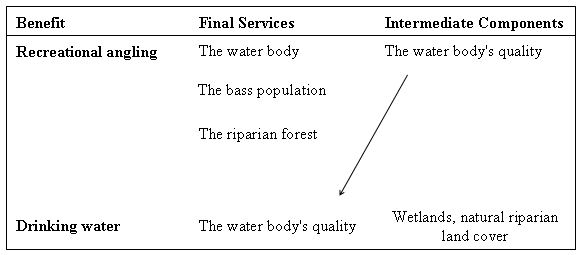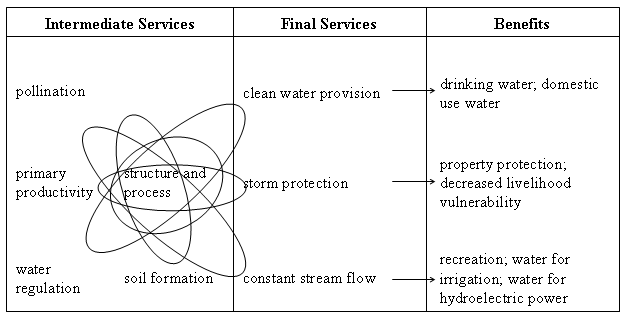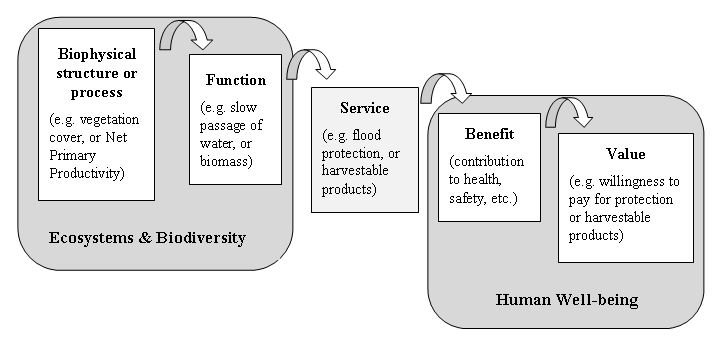2 Definitions of the different key terms
If the ecosystem service concept is designed to provide an effective framework for natural resource management decisions, ecosystem services have to be defined and classified in a way that allows comparisons and trade-offs amongst the relevant set of potential benefits. A number of scientists have attempted to construct typologies of ecosystem services (e.g. Daily, 1999*; de Groot, 2006*; Boyd and Banzhaf, 2007*). However, ambiguity in the definitions of key terms – such as ecosystem processes, functions, services and benefits – makes it difficult to develop a coherent decision framework (Wallace, 2007*). For meaningful comparisons across time and space, clear definitions of the key terms are required (Boyd and Banzhaf, 2007*; Wallace, 2007*). However, according to Boyd and Banzhaf (2007*) ecology and economics have failed to standardize the definition and measurement of ecosystem services. The following brief survey of definitions reveals multiple, competing meanings of the key terms used in the literature referring to the ecosystem service concept.
Ecosystem processes.
According to the Elsevier’s Dictionary of Biology (Tirri et al., 1998) “process” is defined as “a series of events, reactions or operations, achieving a certain definite result”. Ecosystem processes are seen therefore as the complex interactions among biotic and abiotic elements of ecosystems, encompassing in broad terms material cycles and flow of energy (Lyons et al., 2005). Although this definition is widely accepted, scientists interpret and classify processes in different ways. Balmford et al. (2008), for example, distinguish between “Core Ecosystem Process” (e.g. production, decomposition, nutrient and water cycling), “Beneficial Ecosystem Process” (e.g. biomass production, pollination, biological control, habitat and waste assimilation), and “Benefits” (e.g. food, fresh water).
Ecosystem functions.
De Groot (1992*) defines ecosystem functions as “the capacity of natural processes and components to provide goods and services that satisfy human needs, directly or indirectly”. Functions therefore are the subset of biophysical structures and processes that provide services (de Groot et al., 2010*). They can refer variously to the habitat, biological or system properties or processes of ecosystems (Costanza et al., 1997*). Most authors agree that goods and services are generated by ecological functions (or processes) (e.g. Costanza et al., 1997*; Daily, 1997*; Farber et al., 2006*). Jax (2005) notes that the term “ecosystem function” is considered as “capability”, but is often used more generally to refer to processes that operate within an ecosystem, like nutrient cycling or predation. Often the two terms ecosystem functions and ecosystem processes are commonly used as synonyms even within the same study (see Costanza et al., 1997*).
Ecosystem services.
Ecosystem services can be simply defined as a set of ecosystem functions that are useful to humans (Kremen, 2005). They are consequences of supporting processes acting at various temporal and spatial scales (Farber et al., 2006*). These general definitions are widely accepted. However, when trying to classify services and applying this framework in decision making processes, several uncertainties are revealed. There exist various semantic classes of the term ecosystem services, depending on the specific goal or background (Fisher et al., 2009*). According to Costanza and Folke (1997*) ecosystem services “represent the benefits human populations derive, directly or indirectly, from ecosystem functions”. In Daily (1997*) ecosystem services (also referred to as nature’s services) are the “conditions and processes”, as well as the “actual life-support functions”. Following Eichner and Tschirhart (2007*), those biological resources are referred to as ecosystem services, which provide inputs into both production processes and consumers’ well-being. The definition in the MEA (2003*), which has been widely taken-up in the international research and policy literature, highlights the strong relation of ecosystem services to the benefits people derive directly or indirectly from ecological systems. Based on the MEA approach, the TEEB (The Economics of Ecosystems and Biodiversity) project defines ecosystem services as direct and indirect contributions of ecosystems to human well-being (TEEB, 2010*). Boyd and Banzhaf (2007*) provide an alternative approach. In their definition, ecosystem services are ecological components (including ecological structure) directly consumed or enjoyed to produce human well-being. Thus indirect processes and functions are not ecosystem services, but intermediate ecological components. For instance, recreational angling is seen as a benefit with multiple inputs. Whereas the water body and the target fish population are final services, the food web and water purification land uses on which the fish population depends, are intermediate components, because they are not directly related to the benefit (Figure 2*).Figure 2: Final Services vs. Intermediate Components regarding the benefits “recreational angling
and drinking water”; Whereas Intermediate Components are indirect processes and functions, Final
Services are directly consumed or enjoyed to produce human well-being (after Boyd and Banzhaf,
2007*).
In contrast to the definition above, Fisher et al. (2009*) suggest that ecosystem services are “the aspects of ecosystems utilized (actively or passively) to produce human well-being”. Therefore services encompass ecosystem organization and structure as well as process and/or functions if they are consumed by humanity either directly or indirectly (Figure 3*).
Figure 3: Conceptual relationship between Intermediate and Final Services; Structure and Processes
become Intermediate Services if there are humans that benefit from them. Interactions among several
Intermediate Services produce Final Services such as “clean water provision” and “storm protection”
(after Fisher et al., 2009*).
Landscape services vs. ecosystem services.
Another approach is to define functions and services at landscape scale to integrate the concept into land management decisions. The awareness that landscapes provide a multitude of functions and are subject to many possible land uses, gives rise to increasing research interest on the linkages between land use and land(sape) functions (see Bakkera and Veldkamp, 2008; Pérez-Soba et al., 2008*; Verburg et al., 2009*). Therefore, recently the terms “landscape function as well as landscape service” have become more important in the literature (Bastian and Schreiber, 1999*; de Groot et al., 2010*; Willemen et al., 2010*). As “landscapes” (contrary to “ecosystem”) may be more attractive to non-ecological scientific disciplines and may be associated with people’s local environment, the term “landscape services” is preferred as a specification (rather than an alternative) of ecosystem services. In addition, the terms “environmental” and “green” services are used in some articles (Termorshuizen and Opdam, 2009). Within this present paper landscape functions and services are used as a synonym to ecosystem functions and services. As the debate on the definitions is still going on and several authors have different interpretations and preferences, we don’t follow specific definitions of the key terms in order to assure the provision of an overview.
Benefits.
A benefit is something that directly impacts on the well-being of people (Fisher and Turner, 2008*). Well-being is declared as the opposite end of a continuum from poverty, which has been defined as a “pronounced deprivation in well-being” (MEA, 2005*). As well-being is dependent on one’s situation, cultural and ecological circumstances, benefits are spatially explicit (Boyd and Banzhaf, 2007*). Resources of well-being encompasses factors like aesthetic, enjoyment, various forms of recreation, maintenance of human health, physical damage avoidance, and subsistence of food (Boyd and Banzhaf, 2007*). Defined this way, benefits can be seen as the link between human welfare and ecosystems, on which theoretically an economic value can be put on. The benefits humans gain from ecosystems are derived from services (Fisher and Turner, 2008*). As mentioned above, the MEA (2003*) and also other scientists (e.g. Costanza et al., 1997*; Wallace, 2007*) consider services and benefits to be the same. Recently, another scientific discourse has suggested that human well-being is not only dependent on nature, but also on other landscape elements, which have therefore to be also taken into account (Carlisle et al., 2009). Especially, in affluent societies well-being can be understood as socio-cultural constructions of modernity which comply with the demands of a capitalist economic system (Eckersley, 2005*). A multidisciplinary and culturally informed focus on well-being is thus necessary to be able to realise that certain aspects of “modern life” affect the physical environment on which humanity depends.
Conceptual relationship among the “key terms”.
Haines-Young and Potschin (2010*) provide a valuation framework for linking ecosystems to human well-being, which has been used in several projects, for instance, the TEEB project (TEEB, 2010*) (Figure 4*). The proposed diagram makes a distinction between ecological processes and functions as well as the provided services and the outputs considered for humans as benefits. However, in the real world the relationship is not as simple and linear as illustrated in the diagram. Although the general structure of the suggested framework is widely agreed upon, the distinction between the terms “function”, “service” and “benefit” is still under discussion (de Groot et al., 2010*). Fisher et al. (2009*), for example, propose a different conceptual relationship between the key terms (Figure 3*). It shows how joint products (benefits) can stem from individual services. Intermediate services are based on complex interactions between ecosystem structure and processes and lead to final services, which provide human welfare benefits.Figure 4: Conceptual relationship between Ecosystems & Biodiversity and Human Well-being
(adopted from Haines-Young and Potschin, 2010).







